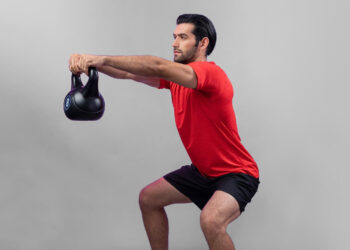Calories Burned With Abdominal Roll Wheels
Depending on your weight and exercise intensity, you’ll burn about 4.8 calories for each minute you do abdominal roll wheels, which equates to 288 calories per hour. If you can do 15 roll wheels in one minute, that means each roll wheel repetition will burn about 0.32 calories.
Calories Burned with Ab Exercises (weight: 170 lbs)
| Exercises | MET | 30 min. | 60 min. |
|---|---|---|---|
| Ab Exercises | 7 | 283 | 567 |
| Abdominal Roll Wheel | 4 | 162 | 324 |
| Bicycle Crunches | 2.9 | 117 | 235 |
| Crunches | 2.8 | 113 | 227 |
| Hanging Knee Tucks | 3.2 | 130 | 259 |
| Reverse Crunches | 3 | 122 | 243 |
| Side Crunches | 2.9 | 177 | 235 |
| Side Plank | 5 | 202 | 405 |
| Burpees | 8 | 324 | 648 |
| Bridges | 6 | 243 | 486 |
How the Calculator Works
The abdominal roll wheel calculator uses MET values to give you an accurate estimate of how many calories you can expect to burn. The higher the MET value, the more calories you will burn from doing this exercise.
MET
MET stands for metabolic equivalent of task and the MET value gives us an estimated expenditure of energy for many different activities and exercises.
A MET value is a ratio between the working metabolic rate and the resting metabolic rate [1], which is the rate of energy that is used relative to the duration of time spent doing activities such as abdominal roll wheels.
This means that a MET value of 1 is the equivalent of the amount of energy you expend while at rest, and a MET value of 4 means you are expending 4 times as much energy compared to being at rest.
Pretty much all common activities and exercises have MET values assigned to them. Some activities with MET values are common, and some are not so common. For example, there are MET values assigned to activities like hunting, painting, and meditating.
Level Up Your Fitness: Join our 💪 strong community in Fitness Volt Newsletter. Get daily inspiration, expert-backed workouts, nutrition tips, the latest in strength sports, and the support you need to reach your goals. Subscribe for free!
Most activities come with varying levels of intensity and have different MET values assigned to them. However, the abdominal roll wheel only has a MET value of 4 assigned to it.
Formula
The formula that our calculator uses to determine the number of calories burned per minute is (body weight in Kg x MET x 3.5) ÷ 200.
Examples
A person weighing 150 pounds will burn approximately 288 calories per hour from doing abdominal roll wheels. This activity has a MET of 4, which means that it burns 4 times as many calories compared to being at rest.
This is what the formula for calculating the calories burned will look like for a 150-pound individual at a MET value of 4.
- Calories burned (per minute) = (body weight in kg x MET x 3.5) ÷ 200
- Calories burned (per minute) = ( 68 x 4 x 3.5 ) ÷ 200
- Calories burned (per minute) = 4.8 calories x 60
- Calories burned (per hour) = 288 calories per hour
How to Do Abdominal Roll Wheels
Having a strong and developed core will help you succeed in many other compound lifts like the squat, deadlift, bench press, and more. This is why using the abdominal roll wheel to strengthen your core is a great exercise to add to your routine.
The abdominal roll wheel is a versatile piece of equipment that can be used in a number of different ways. Here’s how to do the most popular form: the kneeling ab wheel roll out.
- To begin the abdominal roll out, start by sitting on your knees. Use a soft mat to kneel on to make it easier on your knees.
- Grab the wheel on both sides and roll out as far as you can. Keep your back straight throughout the movement and make sure to stay in control while rolling out.
- Reverse the movement with control, and return to the starting position.
- Repeat the movement for as many reps as you can. Beginners should shoot for 8 to 10 reps. Intermediate 12 to 15 reps. Advanced 20 to 30 reps.
Muscles Worked with the Abdominal Roll Wheel
While you may think that the abdominal roll wheel only targets the core region, you’d be mistaken. This exercise is so dynamic that it works several different muscle groups in addition to the core.
While the core is responsible for flexing the torso and pulling your ribcage to your spine, the abdominal roll wheel also targets many of the muscles of the upper back and shoulders.
You may also see the abdominal roll wheel compared to pull-ups since they both target your abs, lats, and the front part of the shoulders when done correctly.
Tips & Techniques
Those that are new to the bridge exercise may find it difficult to do without the proper training beforehand. Below are some additional tips that you may find helpful if you’re just starting to work this exercise into your routine:
- Keep your core engaged while doing the exercise. You should be able to clench your abs and feel the burn as you perform a bridge.
- Make sure that you are continuously breathing while doing bridges. You may find yourself holding your breath during the exercise, but constant controlled breathing is crucial for performing this exercise.
- If you notice your form suffering, you should take a break and try the exercise again in a few minutes. Don’t be afraid to decrease the resistance if it’s too much.
Benefits of the Abdominal Roll Wheel
Building core strength
We can’t emphasize enough the importance of having a strong core. The abdominal roll wheel improves your core strength since you need to stabilize the spine to perform the exercise correctly.
Many fitness trainers will contend that the abdominal roll wheel is more effective than crunches or sit-ups since the exercise works several different muscle groups.
Improve balance, stability, and posture
Having a strong core is good for more reasons than just showing off your six-pack abs. A developed core allows you to improve your balance and stability which can help you in other ways in the gym.
Athletes will find that abdominal roll wheels improve their athletic performance due to the improvement in stability. You’ll also find that a strong core gives you better posture and makes you feel more confident in your daily life.
Level Up Your Fitness: Join our 💪 strong community in Fitness Volt Newsletter. Get daily inspiration, expert-backed workouts, nutrition tips, the latest in strength sports, and the support you need to reach your goals. Subscribe for free!
Full-body cardio workout
The abdominal roll wheel is essential if you want to work your lower body in addition to your core and upper back. The exercise activates both the upper and lower body as you rotate while doing the exercise.
Being able to do abdominal roll wheels for an extended amount of time will increase endurance and add to the total number of calories you burn in one gym session.
Variations
For those that want a challenge or feel like the traditional kneeling abdominal roll wheel is becoming too easy, there are plenty of different variations that you can try to make things more challenging and more effective.
Since the abdominal roll wheel is so versatile, there are additional exercises that you can do with the roll wheel that target different muscles than the traditional exercise.
Standing Ab Wheel Roll-Outs
The standing ab wheel roll-out is an extremely effective alternative to the kneeling roll-out that you can expect will shred your midsection. This exercise is best for intermediate or advanced lifters and beginners may find that it’s too difficult.
To start with the standing ab wheel roll-out, you should stand up tall with your legs shoulder-width apart and holding the ab wheel with both hands. Then bend your knees and lean forward and downward until you’re on the floor with the ab wheel breaking your fall.
Keeping your core tight and engaged, roll the wheel forward and keep your back slightly rounded to not hyperextend it. You should make sure to breathe normally and continue to exhale.
Then roll the wheel back toward the body and stand up when it’s as close to you as possible. You should repeat this routine for 5 to 10 reps.
The standing ab roll-out is an advanced version of a plank and will be difficult for many people who haven’t done it before. In order to improve your ability to do standing roll-outs, be sure to practice planks and other physio ball roll-outs regularly.
V Roll-Outs
V roll-outs are similar in nature to the standard knee roll-out but aim to target the obliques more effectively. To begin doing V roll-outs, you’ll start in the same kneeling position as a regular roll-out.
Then keep your arms extended and roll out to about a 45 degree angle to your right hand side. Then return to the starting position and repeat this same movement but with a 45 degree angle to the left.
Keep repeating the exercise until you can do about 5 to 10 reps, and then move on to doing 15 to 20 repetitions each set.
Lateral roll-outs with rowing machine
If you want to take your core to the next level, this next variation will push you to the limits.
The lateral roll-out is an advanced variation that uses the rowing machine to make the exercise more difficult.
Start by placing your forearm on the seat of the rowing machine and perform the lateral roll-out. Make sure that you don’t mindlessly hang out on your arm. Instead protract the shoulder blade and press the body away from the seat.
Your feet should be in a set position as well. You should place the foot of the upper leg slightly ahead of the bottom foot instead of stacking one foot on top of the other. Be sure to practice good form and if your form suffers, take a break and try again.
FAQs
How many calories do you burn doing ab roller?
Ab Roller exercise burns approximately 4.8 calories for each minute (depending on body weight, metabolism rate, and muscle-to-fat ratio).
The Bottom Line
The abdominal roll wheel is a dynamic exercise that provides many different benefits to those that choose to incorporate it into their routine.
The kneeling variation is perfect for beginners, while intermediate and advanced lifters can move onto the standing roll-out and other variations that we’ve discussed.
Use this calculator to get an idea of how many calories you can expect to burn with abdominal roll wheels, and be sure to check out all the other calculators that we have to offer at Fitness Volt!
References:
- Jetté, M., Sidney, K., & Blümchen, G. (1990). Metabolic equivalents (METS) in exercise testing, exercise prescription, and evaluation of functional capacity. Clinical cardiology, 13(8), 555–565. https://doi.org/10.1002/clc.4960130809

















